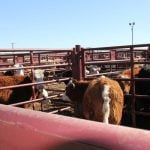CNS Canada — The late spring has prompted many Prairie cattle owners to put their animals on pasture weeks ahead of schedule, according to three industry watchers.
“They are probably three weeks early (in Alberta) compared to when they should be turning them out,” said forage specialist Barry Yaremcio at the provincial Ag-Info Centre at Stettler, Alta.
Much of the problem, he said, can be traced back to the late harvest and cold winter which prompted cattle to consume 25 to 30 per cent more feed than normal. As a result, supplies are low in most areas.
Read Also

Prairie forecast: Active pattern continues with mostly-dry west, wet start for east
The active pattern that we saw last week looks to continue into this forecast period which means more chances for rain, possibly some wet snow and a continuation of the temperature rollercoaster ride.
Some pasture has started to turn green, but Yaremcio said he worries it’s still too soon for cattle to be out there.
“The cows are going out there and making some of these pastures look like pool tables.”
Some producers are also using low-priced oats to help get their animals through the stretch, according to provincial forage specialist Terry Kowalchuk in Regina.
“If people can utilize existing feed stocks to give their grass a chance to establish it would be a good idea,” he said, adding grasses are more vulnerable coming out of dormancy.
However, many producers are reluctant to spend money on feed when spring is right around the corner, according to Glenn Friesen of Manitoba Agriculture at Carman.
Some producers, he noted, are combining their supplies by moving bales directly into pastures.
“They’re cautiously doing this knowing there could be issues by mid-summer when these pastures that they graze now will be in poorer health.”
Despite the lingering effects of the cold weather, the officials say they’re not aware of any areas experiencing severe or dire feed shortages. Some areas are good and some are tight with no broad patterns.
“It’s spotty, all over the place,” said Yaremcio.
— Dave Sims writes for Commodity News Service Canada, a Winnipeg company specializing in grain and commodity market reporting.
















